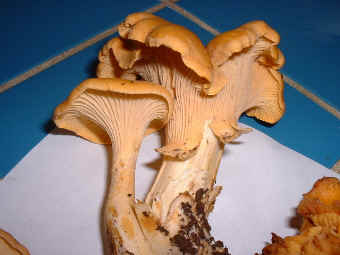|

Special Issue
Treasures from Banks, Oregon
Fall, 2004, 2007, 2009
Back to SPECIAL ISSUES
page
1 | page 2 | page
3 | page
4 | page 5
| page 6 | page 7
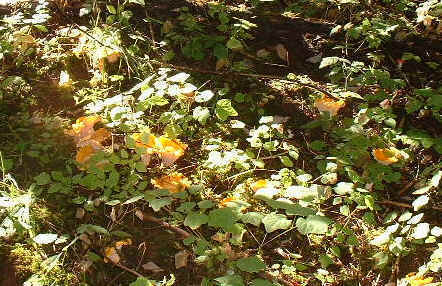
The Geiger's Back Yard, 10/06/04 (Golden Chanterelles)
This year has been a pretty wet year for Oregon, and
in most places, a great year for finding fungi. The following is a
dialog, with accompanying pictures, between me and our friends Robert and Rebecca
Geiger, who live in Banks, Oregon.
|
From the
Geigers, September 18, 2004:
We haven't had a lot of time to go wild 'shroom hunting this year - so we just go out into the back yard and round up the tame ones! This popped up in the same place as the (smaller) one that we harvested last year - we've had quite a little bit of rain in the last week or so, so they will be popping up all over the place.
From me, September 18, 2004:
If it
is the Agaricus augustus again, it
should have that characteristic almond odor, with white gills when young,
pinkish briefly, which will eventually turn dark brown.
It is supposed much better tasting when younger, so you should check your
yard daily.
And thanks for the yummy-looking, beautiful photos.
|
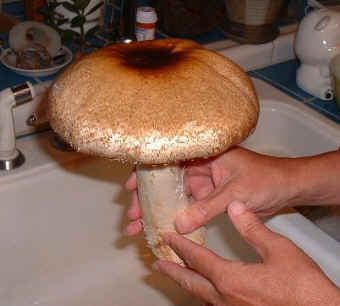 |
|
From the
Geigers, October 3, 2004:
Well, Herman, there are mushrooms popping up all
over right now. We had several weeks of rain, then it cleared off and
got warm, and I guess they like it. David Arora's two books are a great source for reference - based on that,
looks like we have Lactarius Rufus and Amanita Calyptrata popping up in
various places.
Here is a picture of some mushrooms we found this afternoon under our
Douglas Fir trees - we believe it matches the description in the D. Arora
hip pocket guide as Fat Jack, or Suillus caerulescens & S.
Ponderosa.
Fairly common, I guess, and nothing so notable as to edibility, but it is
fun to be finding more types and learning.
|
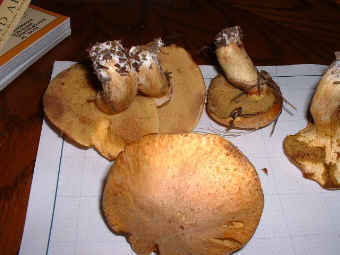 |
|
From me: October 3, 2004:
It does look
like a member of the Suillus genus. It is a hard one for me to ID, as
there are many that look similar in one stage or another.
None of the Suillus are known to be
poisonous, but only a few are considered even worth tasting, at least here
in the USA.
I have seen a few out recently also, have
tried tasting a few in the past, but will probably never try them again
unless they were prepared by someone who knows the best way to cook them.
Have you been finding the Chanterelles in
your yard?
And thanks again for sending all the pictures.
From the
Geigers, October 9, 2004:
Good Saturday morning,
Herman
Here are the results of a little more mushroom hunting we have done in the
woods around the house. The big white one is, I am pretty positive,
Russula brevipes, but I am not sure on the other, smaller brown one.
It has no veil, ring, or volva. Spores are white. The closest I
can get in the books is the Deer Mushroom, or Pluteus cervinus. The
mature gills are a dark tan color, and the stalk is brownish, so it does not
quite match the pictures in the book. Any ideas?
|
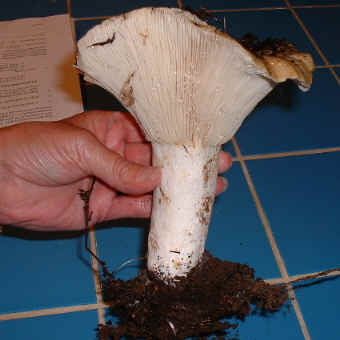
|
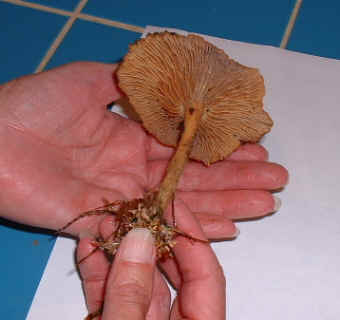
|
|
From me: If it had a trace of latex, and it had a smell like maple syrup, it could be a Lactarius fragilis or rufulus.
Otherwise it looks something like a Laccaria laccata.
If either, they are edible.
Herman
From the
Geigers, October 9, 2004:
If we did out homework right these should be
Chanterelles. Lots of them in woods just below house.
Seems to be banner year for Mushrooms.
Bob & Rebecca
From me, October 10:
What a find!
These are indeed the Golden Chanterelles, either Cantharellus formosa
or C. cibarius.
The only thing similar to the Golden Chanterelle is the Scaly Chanterelle,
or those of the Gomphus genus, but these are not normally eaten on the West
Coast, except one called Pigs Ears. I don't see any scales.
Taste one slowly cooked in butter, and if you like it, cook the rest and
freeze them for our visit north.
It is one of our favorites, mainly for texture but also for how good it
tastes in certain preparations.
I hear that there were so many out this year in Oregon, that the commercial
pickers are sometimes only getting 50 cents a pound for them.
ENJOY!
Herman
|
From the
Geigers, October 10, 2004:
Herman - We have been happily munching on the
Cantharellus cibarius since yesterday. This morning Bob went down into
the woods and brought back these - Cantharellus subalbidus! I must
confess I like the flavor better than the Golden Chanterelle. We found
a nice bed of them, and not too far away from the Golden.
I have fried them up with a bit of butter, garlic, and a splash of very dry
sherry. Sake is also nice. Cooked both varieties the same way,
and do like the White better.
Bob & Rebecca
From me, October 10, 2004:
I myself like to think that the white ones
are better than the golden ones, but that may be because I haven't found the
golden ones up here yet.
I have heard about them being up here, but probably only after real wet rain
falls.
Herman
|
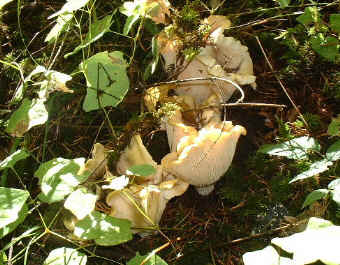
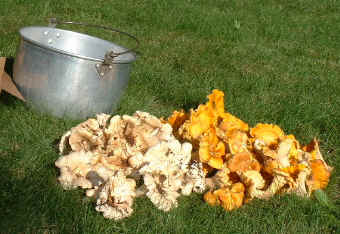
|
|
From the
Geigers, October 15, 2004:
Still working on an id on this
guy. I will pick some tomorrow and get more info. The other we think is the fried chicken
mushroom: white gills, white stems, white spores. Been dry all week; weatherman says rain tomorrow. Good year to take mushroom pictures!
From me: You could be right about the Fried Chicken Mushroom
(Lyophyllum decastes).
I have found them here, but in tighter clumps. It has a nice taste and texture.
I think it looks kind of like a Honey Mushroom (Armillaria mellea), except for the thicker stalk, the ground habitat, and the lack of a ring on the stalk.
|
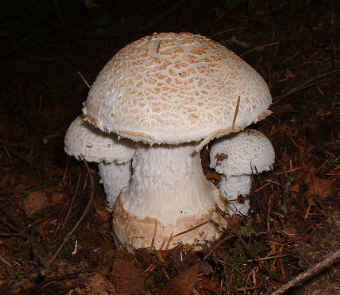
|
|
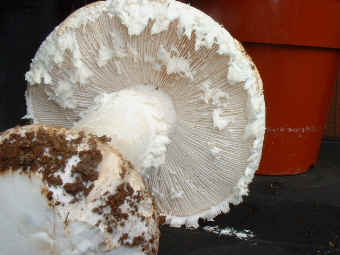

|
|
From the
Geigers, October 16, 2004:
Hi, Another picture for your files. This one
also has white gills and
white spores. The one we found yesterday we think is some kind of Amanita. At any rate
we are NOT going to eat them. Just thought you might like to see them.
Bob & Rebecca
From me: This one looks like a Tawny Grisette, or
Amanita fulva, because of the striations on the cap.
The pictures of the other one with the volva I will forward to my Amanita expert friend to see what she says. She might want you to save it dried, so I will let you know as soon as I hear back from her.
I like seeing the pictures. Please keep taking
them!
Herman
|

|
|
From me: This is a dialog I had with from one of my amanita expert
friends in
regards to the amanitas. If you still have the white one or can find another, she
would appreciate it if you could measure and dry it, and save it for her.
Herman
From me to Debbie Viess:
Hi Debbie,
Here are some pictures from a friend who lives in Banks OR, and who has been finding lots of mushrooms on
her property, including both white and golden chanterelles. She thinks these two pictures are of
an Amanita.
She also has one that I told her looked like an Amanita fulva - tan-orange cap with striations and
long thin stem.
Have you ever seen one like this and do you want me to have
it dried for you?
Have any ID ideas?
From Debbie Viess:
Herman,
No, I have never seen this mushroom. I agree that it looks like an amanita,
Sect. Lepidella (friable
universal veil). I searched thru Lindgren, Thiers and Jenkins, but found no
good match. Sure, have your
friend measure it first (cap diameter, width of stipe, height), then dry it.
Fulva, or a fulva-esque grisette is possible...they have been reported from
WA. I wouldn't advise eating
it, however. Rod Tulloss claimed to have seen at least 4 different amanita sp.,
similar to fulva, in one of
our local herbariums (either SF State or UC).
Debbie
From Jan Lindgren:
Hi,
I think the amanita is A. smithiana with the base partially cut off. When the weather dries out, the brown crust can form on smithiana as seen in the picture. It also resembles A. silvicola with all the fluffy annulus tissue, but I think there is more to the base than what is shown in the pictures. I really don't think it is anything other than one of the above.
When ever you harvest an amanita be sure to dig it out so all of the base is collected. The long "rooting" extension of the base on A. smithiana often goes into rotten wood and I have seen one that was about 20 inches long. Amanita silvicola is a shorter and usually smaller mushroom than A. smithiana, but both grow in your area.
Jan
|
next page >
Back to HOMEPAGE
|






